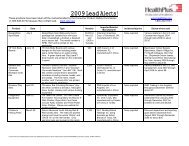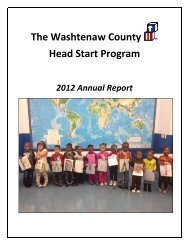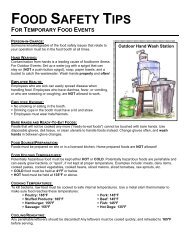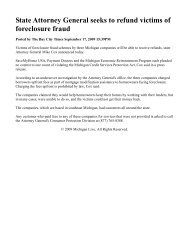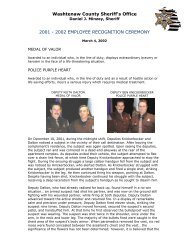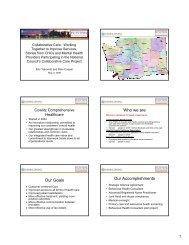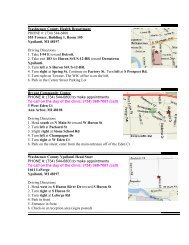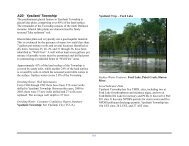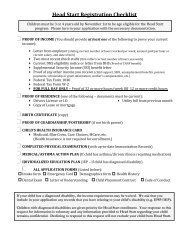Water Protection Activities in Washtenaw County
Water Protection Activities in Washtenaw County
Water Protection Activities in Washtenaw County
You also want an ePaper? Increase the reach of your titles
YUMPU automatically turns print PDFs into web optimized ePapers that Google loves.
<strong>Water</strong>shed Plan BMP Title BMP Description BMP Outcome<br />
Upper Grand River<br />
<strong>Water</strong>shed Management<br />
Plan (Center, Grass, and<br />
Wolf Lake<br />
Subwatershed) Conservation Tillage<br />
Upper Grand River<br />
<strong>Water</strong>shed Management<br />
Plan (Center, Grass, and<br />
Wolf Lake<br />
Subwatershed) Cover/Green Manure Crop<br />
Upper Grand River<br />
<strong>Water</strong>shed Management<br />
Plan (Center, Grass, and<br />
Wolf Lake<br />
Subwatershed) Terraces<br />
Upper Grand River<br />
<strong>Water</strong>shed Management<br />
Plan (Center, Grass, and<br />
Wolf Lake<br />
Subwatershed) Stream Bank Stabilization<br />
Upper Grand River<br />
<strong>Water</strong>shed Management<br />
Plan (Center, Grass, and<br />
Wolf Lake<br />
Subwatershed) Bioretention Areas<br />
Upper Grand River<br />
<strong>Water</strong>shed Management<br />
Plan (Center, Grass, and<br />
Wolf Lake<br />
Subwatershed) Constructed Wetlands<br />
Upper Grand River<br />
<strong>Water</strong>shed Management<br />
Plan (Center, Grass, and<br />
Wolf Lake<br />
Subwatershed) Wet Ponds<br />
Stony Creek <strong>Water</strong>shed<br />
Management Plan<br />
Develop Stony Creek <strong>Water</strong>shed<br />
Council<br />
Utilize a number of strategies and techniques for<br />
establish<strong>in</strong>g crops <strong>in</strong> the previous crop's residues, which<br />
are purposely left on the soil surface Reduces negative impacts of sediment<br />
Utilize Cover crops like grasses, legumes, or forbs, or use<br />
Green Manure, for seasonal coverage to reduce the<br />
potential of erosion Reduces negative impacts of sediment<br />
Construct earthen embankments or ridge and channel<br />
systems that hold moisture and help trap sediments,<br />
m<strong>in</strong>imiz<strong>in</strong>g sediment-laden runoff Reduces negative impacts of sediment<br />
Plant trees, shrubs, and grasses, bank cover, riprap, etc, to<br />
ma<strong>in</strong>ta<strong>in</strong> stream channel capacity and protect bank<br />
structure Reduces erosion and sedimentation<br />
Construct ra<strong>in</strong> gardens or other landscap<strong>in</strong>g features<br />
provide on-site treatment of storm water runoff<br />
Create wetlands, additional acreage improves surface and<br />
groundwater quality<br />
Construct bas<strong>in</strong>s that have a permanent pool of water<br />
throughout the year to treat <strong>in</strong>com<strong>in</strong>g storm water runoff<br />
by allow<strong>in</strong>g particles to settle and algae to take up<br />
nutrients.<br />
152<br />
Reduces negative impacts of sediment, nutrients, and provides runoff<br />
detention<br />
Reduces negative impacts of sediment, nutrients, and provides runoff<br />
detention<br />
Reduces negative impacts of sediment, nutrients, and provides runoff<br />
detention<br />
Discuss issues related to Stony Creek <strong>in</strong>clud<strong>in</strong>g plan<br />
implementation Encourages cont<strong>in</strong>ued cooperation between jurisdictional




